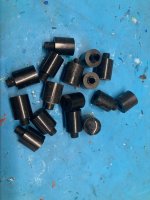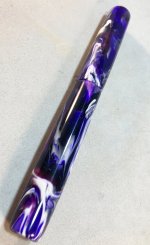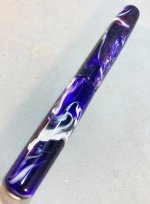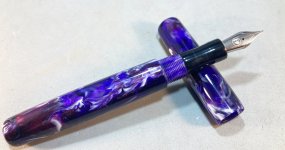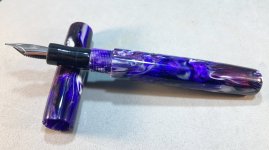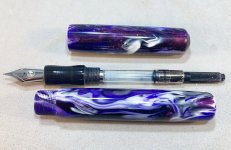Kevin,
I'm glad this may have helped. Here are a few more thoughts.
My section threads are M10x1, so I just use a 10mm bit and drill into the barrel section about 1.5mm to remove the first bit of internal threads. Here is a picture that may help.
View attachment 383471
I haven't ordered one of those double ended mandrels from Rick "yet".

I have one of his older ones so I am holding the section by its external threads, BUT... I use a live center in the open end to steady during shaping. I only pull the live center out for the last little bit of shaping on the very end.
Rick's step drill is designed to be used to drill 1.077"
from the tip of the bit. Most of the time drilling, we are measuring from the edge of the cutting edge/beginning of the flute. Use a caliper to mark the bit that 1.077" from the very tip of the bit and I think you will get the results you are looking for.
I'm glad it helped.
I find order of operations creating sections to be critical. Here is my order of operations (simplified):
- With section blank in collet chuck, face the end and cut the tenon. I use the Hinze tenon cutter.
- Thread the tenon. While doing this, I leave the 6mm tenon cutter shaft in the blank for strength. Remove shaft after threading tenon.
- Reverse the blank in the collet chuck.
- Part blank off and face to desired length.
- Using Rick's Jowo #6 step bit drill in 1.077" from tip of bit.
- Using M7.4x0.5 tap, tap internal/nib housing threads into section blank.
- Remove from collet chuck mount on mandrel and shape with live center in open end.
This is my order so that I leave as much material as possible to support these operations. I realize that flipping the blank in the collet chuck "could" introduce some concentricity issues, but I haven't had an issue. If I feel the blank is out of round, I will chuck it up and surface it to round before starting this process. Also, I wouldn't want to try to drill and tap the internals while holding it by the section threads.
If you have more questions or want to chat through something, shoot me a DM and we can get on the phone sometime.
David
